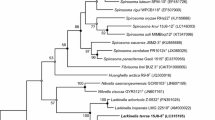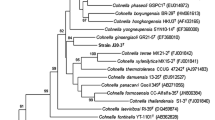Abstract
A Gram-negative, strictly aerobic, non-motile, rod-shaped bacterium, designated THG-S6.8T, was isolated from soil in Incheon, South Korea. Based on 16S rRNA gene sequence, strain THG-S6.8T was moderately related to Massilia plicata 76T (97.3 %), Massilia dura 16T (97.2 %) and Massilia albidiflava 45T (96.9 %). Chemotaxonomic data revealed that strain THG-S6.8T possesses ubiquinone-8 as the predominant respiratory quinone, and summed feature 3 (C16:1 ω7c and/or C16:1 ω6c) and C16:0 as the major fatty acids. The major polar lipids were found to be phosphatidylethanolamine, phosphatidylglycerol and diphosphatidylglycerol. The DNA–DNA relatedness between strain THG-S6.8T and Massilia plicata KCTC 12344T and Massilia dura KACC 12342T was 38.7 and 40.5 %, respectively. The DNA G+C content was 66.8 %. These data, together with phenotypic characterization, suggest the isolate represents a novel species, for which the name Massilia humi sp. nov. is proposed, with THG-S6.8T as the type strain (=KCTC 42737T = CCTCC AB 2015296T).

Similar content being viewed by others
References
Bodour AA, Wang JM, Brusseau ML, Maier RM (2003) Temporal change in culturable phenanthrene degraders in response to long-term exposure to phenanthrene in a soil column system. Environ Microbiol 5:888–895
Collins MD, Jones D (1981) Distribution of isoprenoid quinone structural types in bacteria and their taxonomic implications. Microbiol Rev 45:316–354
Ezaki T, Hashimoto Y, Yabuuchi E (1989) Fluorometric deoxyribonucleic acid-deoxyribonucleic acid hybridization in microdilution wells as an alternative to membrane filter hybridization in which radioisotopes are used to determine genetic relatedness among bacterial strains. Int J Syst Bacteriol 39:224–229
Felsenstein J (1981) Evolutionary trees from DNA sequences: a maximum likelihood approach. J Mol Evol 17:368–376
Felsenstein J (1985) Confidence limits on phylogenies: an approach using the bootstrap. Evolution 39:783–791
Fitch WM (1971) Toward defining the course of evolution: minimum change for a specific tree topology. Syst Zool 20:406–416
Gallego V, Sánchez-Porro C, García MT, Ventosa A (2006) Massilia aurea sp. nov., isolated from drinking water. Int J Syst Evol Microbiol 56:2449–2453
Hall TA (1999) BioEdit: a user-friendly biological sequence alignment editor and analysis program for Windows 95/98/NT. Nucleic Acids Symp Ser 41:95–98
Hiraishi A, Ueda Y, Ishihara J, Mori T (1996) Comparative lipoquinone analysis of influent sewage and activated sludge by high-performance liquid chromatography and photodiode array detection. J Gen Appl Microbiol 42:457–469
Kämpfer P, Nicole L, Karin M, Enevold F (2011) Revision of the genus Massilia La Scola et al. 2000, with an emended description of the genus and inclusion of all species of the genus Naxibacter as new combinations, and proposal of Massilia consociata sp. nov. Int J Syst Evol Microbiol 61:1528–1533
Khammar N, Malhautier L, Degrange V, Lensi R, Godon JJ, Fanlo JL (2005) Link between spatial structure of microbial communities and degradation of a complex mixture of volatile organic compounds in peat biofilters. J Appl Microbiol 98:476–490
Kim OS, Cho YJ, Lee K, Yoon SH, Kim M, Na H, Park SC, Jeon YS, Lee JH, Yi H, Won S, Chun J (2012) Introducing EzTaxon-e: a prokaryotic 16S rRNA Gene sequence database with phylotypes that represent uncultured species. Int J Syst Evol Microbiol 62:716–721
Kimura M (1983) The neutral theory of molecular evolution. Cambridge University Press, Cambridge
Kumar S, Dudley J, Nei M, Tamura K (2008) MEGA: a biologist-centric software for evolutionary analysis of DNA and protein sequences. Brief Bioinform 9:299–306
La Scola B, Birtles RJ, Mallet MN, Raoult D (1998) Massilia timonae gen. nov., sp. nov., isolated from blood of an immunocompromised patient with cerebellar lesions. J Clin Microbiol 36:2847–2852
Mesbah M, Premachandran U, Whitman WB (1989) Precise measurement of the G+C content of deoxyribonucleic acid by high-performance liquid chromatography. Int J Syst Bacteriol 39:159–167
Minnikin DE, Patel PV, Alshamaony L, Goodfellow M (1977) Polar lipid composition in the classification of Nocardia and related bacteria. Int J Syst Bacteriol 27:104–117
Minnikin DE, ODonnell AG, Goodfellow M, Alderson G, Athalye M, Schaal A, Parlett JH (1984) An integrated procedure for the extraction of bacterial isoprenoid quinones and polar lipids. J Microbiol Methods 2:233–241
Moore DD, Dowhan D (1995) Preparation and analysis of DNA. In: Ausubel FW, Brent R, Kingston RE, Moore DD, Seidman JG, Smith JA, Struhl K (eds) Current protocols in molecular biology. Wiley, New York, pp 2–11
Ngo HT, Won K, Du J, Son HM, Park Y, Kook M, Kim KY, Jin FX, Yi TH (2015) Lysobacter terrae sp. nov. isolated from Aglaia odorata rhizosphere soil. Int J Syst Evol Microbiol 65:587–592
Padmanabhan P, Padmanabhan S, DeRito C, Gray A, Gannon D, Snape JR, Tsai CS, Park W, Jeon C, Madsen EL (2003) Respiration of 13C-labeled substrates added to soil in the field and subsequent 16S rRNA gene analysis of 13C-labeled soil DNA. Appl Environ Microbiol 69:1614–1622
Saitou N, Nei M (1987) The neighbor-joining method: a new method for reconstructing phylogenetic trees. Mol Biol Evol 4:406–425
Sasser M (1990) Identification of bacteria by gas chromatography of cellular fatty acids, MIDI Technical Note 101. MIDI Inc, Newark
Skerman VBD (1967) A guide to the identification of the genera of bacteria, 2nd edn. Williams and Wilkins, Baltimore
Stackebrandt E, Goebel BM (1994) Taxonomic note: a place for DNA–DNA reassociation and 16S rRNA sequence analysis in the present species definition in bacteriology. Int J Syst Evol Microbiol 44:846–849
Tamaoka J, Katayama-Fujiruma A, Kuraishi H (1983) Analysis of bacterial menaquinone mixtures by high performance liquid chromatography. J Appl Bacieriol 54:31–36
Tamura K, Stecher G, Peterson D, Filipski A, Kumar S (2013) MEGA6: molecular evolutionary genetics analysis version 6.0. Mol Biol Evol 30(12):2725–2729
Thompson JD, Gibson TJ, Plewniak F, Jeanmougin F, Higgins DG (1997) The CLUSTAL_X windows interface: flexible strategies for multiple sequence alignment aided by quality analysis tools. Nucleic Acids Res 25:4876–4882
Tindall BJ (1990) Lipid composition of Halobacterium lacusprofundi. FEMS Microbiol Lett 66:199–202
Weisburg WG, Barns SM, Pelletier DA, Lane DJ (1991) 16S ribosomal DNA amplification for phylogenetic study. J Bacteriol 173:697–703
Zhang YQ, Li WJ, Zhang KY, Tian XP, Jiang Y, Xu LH, Lai R (2006) Massilia dura sp. nov., Massilia albidiflava sp. nov., Massilia plicata sp. nov. and Massilia lutea sp. nov., isolated from soils in China. Int J Syst Evol Microbiol 56:459–463
Acknowledgments
This work was conducted under the industrial infrastructure program (No. N0000888) for fundamental technologies which is funded by the Ministry of Trade, Industry & Energy (MOTIE, Korea).
Author information
Authors and Affiliations
Corresponding author
Additional information
Communicated by Erko Stackebrandt.
The NCBI GenBank accession number for the 16S rRNA gene sequence of strain THG-S6.8T is KM073948.
Electronic supplementary material
Below is the link to the electronic supplementary material.
203_2016_1195_MOESM2_ESM.pdf
Maximum-likelihood tree based on 16S rRNA gene sequence showing phylogenetic placement of strain THG-S6.8T and related members of the genus Massilia. Numbers at nodes represent bootstrap values over 50 % (1000 resampled datasets). (PDF 15 kb)
203_2016_1195_MOESM4_ESM.pdf
Two-dimensional TLC of total polar lipids of THG-S6.8T (a) and M. plicata KCTC 12344T (b). Abbreviations: phosphatidylethanolamine (PE), diphosphatidylglycerol (DPG), phosphatidylglycerol (PG) unidentified aminolipid (AL), unidentified lipids (L1-4) and unidentified phospholipid (PL) (PDF 53 kb)
Rights and permissions
About this article
Cite this article
Du, J., Yin, C.S. Massilia humi sp. nov. isolated from soil in Incheon, South Korea. Arch Microbiol 198, 363–367 (2016). https://doi.org/10.1007/s00203-016-1195-7
Received:
Revised:
Accepted:
Published:
Issue Date:
DOI: https://doi.org/10.1007/s00203-016-1195-7




